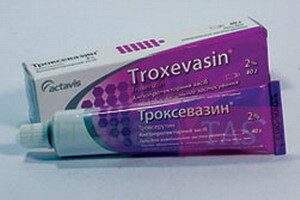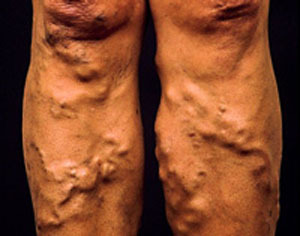 Diseases of the cardiovascular system - a scourge of our lazy high-tech time, when hypodynamia has become the norm of life, and with bad habits most do not have the time and desire to fight.
Diseases of the cardiovascular system - a scourge of our lazy high-tech time, when hypodynamia has become the norm of life, and with bad habits most do not have the time and desire to fight.
Without improving the quality of life, then for a long time people are treated for such consequences as BP veins, thrombosis, and, in fact, phlebitis, paying a considerable amount of time, effort and money.
Phlebitis is not a rare phenomenon, all the complications associated with the expansion of the venous walls of the lower limbs, somehow, lead to phlebitis.
Phlebitis, as mentioned above, is an inflammation that occurs in the injured veins.
As a result of the progression of the disease, the walls of the vessels collapse, most often phlebitis occurs in the lower extremities with varicose veins. The infection( microbes, pathogens) often causes the disease.
This disease often occurs in combination with concomitant pathologies, in particular - the formation of thrombi.
Sometimes phlebitis is caused artificially. For example, sclerotherapy, when a drug is injected that "glues" the inflamed veins, and thus eliminates the varicose veins caused by varicose veins.
Content
- Causes of pathological condition
- Risk Factors
- disease Classification
- Types phlebitis
- symptoms depending on the type
- diseases Diagnostic techniques
- Treatments
- Conservative treatment
- Surgery
- Nuances treatment
- Conclusions regarding treatment
- Complications
- Video: Superficial thrombophlebitis anddeep thrombophlebitis
Causes of the pathological condition
Among the mainIchin lower extremity phlebitis are:
- infection - the main cause of the inflammation( the causative agent in most cases - Streptococcus);
- mechanical damage to the vessel - reaction to the insertion of the catheter, incorrect insertion of the needle during blood sampling;
- effect on the vein of chemicals - chemical burn from the introduction of any drug;
- inflammation of tissues surrounding the vessel - phlebitis as a consequence of a boil or abscess;
- varicose veins - one of the main causes of the disease, often turns into thromboflethmy, and, if not treated - into the trophic ulcer at the site of the lesion.
Risk Factors for
Most often, at-risk groups, one way or another, are associated with varicose veins, and the risk groups that are prone to both diseases often coincide. So, the risk factors for the appearance of the phlebitis include:
- overweight( excessive stress on the legs, cardiovascular system suffers);

- inactivity( lack of motor activity);
- a long static stay in an upright position;
- pregnancy and childbirth( post-partum pain phlebitis possible);
- susceptibility to allergies;
- inpatient treatment, implying the continuous introduction of drugs intravenously.
Classification of the disease
There are several classifications of the disease. In the first place, phlebitis is distinguished depending on its localization:
- endophlebitis - the inner vein of the vein is affected and is, as a rule, traumatic. In addition to the already mentioned catheter and intravenous injections, this kind of phlebitis can provoke a separate injection with a hypertonic solution;
- periphlebitis is a form of inflammation of the outer vein of the vein, which is often provoked by trauma and pathological processes in surrounding tissues;
- panflebit - combines both internal and external processes of inflammation of the vein.
Types of phlebitis
There is also a phlebitis classification for objects that are prone to inflammation-damaged vessels:
- Cerebral is a form of disease with cerebral vascular lesions, the cause may be infection. If there is on the face, then the cause is a purulent inflammation( abscess, phlegmon), which also appeared after infection;
- Postinjection - the category of phlebitis, which is a reaction to the injected drug, can be caused by mechanical and chemical irritation of the vein, this is a separate category, since it arises solely as a reaction to the injected medication;
- The migrating - affects the veins of the extremities, characterized by a tendency to relapse. It covers not only veins, but also in a number of cases - arteries;
- Phlebitis of the collar vein - fairly common. It covers the largest of the veins in the abdominal cavity.
Symptoms depending on the type of the disease
As for the symptomatology, the symptoms common to all types of phlebitis of the lower limbs are pain and hyperemia along the damaged vein.
There are two main types of phlebitis: deep vein thrombophlebitis and superficial phlebitis( deep and superficial veins).
The temperature, pain in the area of damage is noted.
 In the case of acute superficial phlebitis, the vein is painful, tense. Skin over such a vein turns red, thickens. Possible local hyperthermia, red streaks in the areas of the inflammatory process.
In the case of acute superficial phlebitis, the vein is painful, tense. Skin over such a vein turns red, thickens. Possible local hyperthermia, red streaks in the areas of the inflammatory process.
Observes temperature, weakness. Acute phlebitis of the lower extremities of the deep veins observed general hyperthermia, pain and swelling in places of inflammation. The skin in the lesion is pale, without seals and redness.
For chronic form flebit of superficial veins is characterized by smoothed clinical manifestations, the course of the disease is accompanied by relapses and exacerbations.
Cerebral phlebitis is manifested by such symptoms as: headache, high blood pressure, neurologic symptoms.
For pyleflebitis ( collar vein) is characterized by purulent intoxication. There is weakness, pain, vomiting, a cutting sensation in the right hypochondrium, jaundice. It is possible hectic fever with profuse sweating and severe chills.
May enter into a chronic form, traumatizing the abdominal organs.
Diagnostic techniques
Diagnosis directly depends on the severity of the disease.
At the initial stage of the disease, palpation during the lesion can reveal a painful seal or infiltrate, which indicates the scale of the inflammatory process in the subcutaneous tissue.
If it is a question of the form of phlebitis, it is manifested in the form of seals, similar to the protrusion of subcutaneous fat. Such seals should be sought along the bed of an inflamed vein.
 What are the dangers of phlebitis and why does the thrombus come off in humans you can find out in our article.
What are the dangers of phlebitis and why does the thrombus come off in humans you can find out in our article.
What is the essence and danger of such a disease, as lymphostasis of the hand and what you need to know about the disease.
If the inflammatory process captures deep vessels ( deep venous phlebitis of the lower extremities) then its diagnosis is based on complaints such as: pain, subfebrile condition, constant feeling of heaviness. However, such a diagnosis should be made only after careful studies, because there are a number of other diseases.
In general, this disease is little attached to the sex and age of the patient, although it can not be neglected by the fact that over time the vessels wear out.
But the main triggers are still VR veins and infections, from which no one is insured.
Treatment procedures
Treatment of the phlebitis of the lower extremities is mainly conservative.
is shown using compresses with ointments ( Troxevasin, Heparin), thermal physiotherapy. 
There are also a number of measures aimed at the inflammation removal - prescribe Butadion, Aspirin or Reopirin, and also use drugs that restore the trophism of the venous walls of and improve the rheological characteristics of the blood.
These drugs include Escuzan, Trental, Glivenol and Curantil.
In case of defeat of superficial veins, treatment is outpatient, in the case of other pathologies patients are recommended hospitalization and hospital treatment. Therapeutic measures provide for peace and being in an elevated position.
Assign drugs that reduce the viscosity of the blood .Conduct anti-inflammatory procedures.
Conservative treatment of
So, how to treat phlebitis of lower extremities with conservative methods:
- physiotherapy, in some cases hirudotherapy, reflex and phytotherapy;
- administration of certain antibiotics to fight infection;
- is a non-steroidal anti-inflammatory medication;
- for chronic inflammation of the deep veins are prescribed drugs that enhance blood microcirculation;
- may also be prescribed drugs that dilute blood;
- in the treatment of the phlebitis of the lower limbs, complete rest is needed;
- a healthy lifestyle( nutrition, physical activity) contributes to an early cure, with the cessation of smoking - first of all.
In addition to the above measures, the doctor necessarily makes the patient a set of preventive measures to prevent relapses.
Surgical intervention

In the photo, complicated phlebitis of the lower extremities
It is used only in case of threat of deep vein thrombosis in severe form of phlebitis.
Strangely enough, but often causing phlebitis sclerotherapy can become a variant of surgical intervention, as a result of which the affected veins simply disappear with time.
In addition, laser surgery is used to treat phlebitis, directing the light pulse to the diseased vein, and it also disappears with time
. Nuances of treatment of
. In treatment, it is important to remember that in the case of phlebitis caused by trauma to veins after catheterization or chemical exposure,and analgesic procedures.
If the cause of the disease is an infection or BP veins - it is important to begin to eliminate the underlying disease that caused phlebitis, and then relieve the inflammation.
Conclusions on the treatment of
Having considered all possible ways of getting rid of phlebitis, it is possible to cite the following theses:
- The main cause of phlebitis is infection. In this case, the disease can affect almost any part of the body.
- Varicose veins are a frequent companion of this disease. In this case, you need to start with the treatment of VR veins.
- One of the serious forms of phlebitis is thrombophlebitis. Any form of phlebitis can be transformed into this disease, so you need to pay special attention to the composition of the patient's blood.
- Symptoms and treatment of phlebitis depend first of all on which vessels are affected.
- Surgical treatment of phlebitis is indicated only in exceptionally severe cases, while the rest is medicated and with the help of conservative measures.
Complications of
The main complication of phlebitis is, of course, thrombophlebitis with the risk of thrombosis of the affected vein.
In the case of deep vein thrombophlebitis, presents the risk of pulmonary embolism of the pulmonary artery , which is fraught with a fatal outcome. With phlebitis, there can be an intoxication of the body, as well as various infectious complications, such as abscess, phlegmon and others.
Phlebitis is an unpleasant but treatable disease.
With timely attention to this problem, and subsequent intensive treatment along with lifestyle changes, phlebitis will not have time to damage the body too much.
After treatment, it is very important for to strengthen immunity, restore strength and periodically visit a phlebologist, , especially if there is a tendency to such pathologies among family members.
It is important to protect the body, as with other diseases can damage the veins, and this is important to remember. The best prevention of recurrence of phlebitis is to protect the body from infections and excessive static loads, as well as hypodynamia.
Video: Superficial thrombophlebitis and deep thrombophlebitis
How to detect thrombophlebitis in a timely manner and why is it very important? What will happen if the thrombophlebitis spreads to the deep veins tells an experienced phlebologist-doctor.
